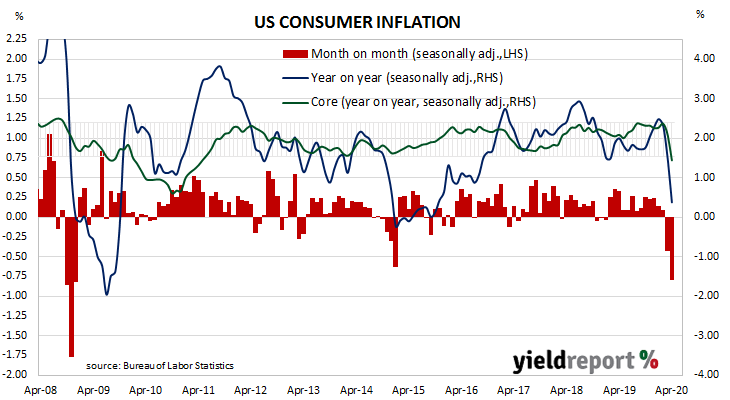Summary: April CPI figures fall at GFC-type rates; food and medical prices up while fuel prices drop; core inflation falls more than expected.
The annual rate of US inflation as measured by changes in the consumer price index (CPI) halved from nearly 3% in the period from July 2018 to February 2019. It then fluctuated in a range from 1.5% to 2.0% through 2019 before rising above 2.0% in the final months of that year. “Headline” inflation is known to be volatile and so references are often made to “core” inflation for analytical purposes. Substantially lower rates for both measures are now starting to be reported.
The latest CPI figures released by the Bureau of Labor Statistics indicated seasonally-adjusted consumer prices decreased by 0.8% on average in April. The fall was lower than the 0.7% fall which had been expected and a larger drop than the -0.4% recorded in March. On a 12-month basis, the inflation rate slowed from March’s annual rate of 1.5% to 0.4%.

Core inflation, a measure of inflation which strips out the volatile food and energy components of the index, decreased on a seasonally-adjusted basis by 0.4% for the month. This was a larger drop than the -0.2% which had been expected and less than March’s -0.1%. The annual rate slowed from 2.1% in March to 1.4%, seasonally adjusted.
ANZ economist Daniel Been said the report “highlighted the scale of the deflationary shock to hit the economy” which he predicted “will be a major focus for the US Fed going forward.”
US Treasury bond yields fell moderately. The 2-year yield shed 2bps to 0.16%, the 10-year yield lost 4bps to 0.67% and the 30-year yield finished 5bps lower at 1.37%.
In terms of likely US monetary policy, expectations of any change in the federal funds rate over the next 12 months remained negligible. However, March 2021 OIS contracts implied a zero effective federal funds rate.

